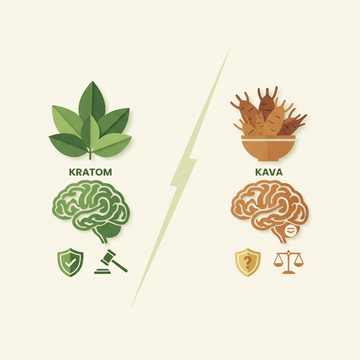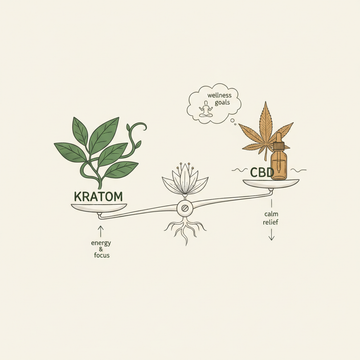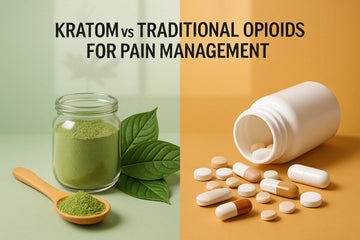When comparing kratom vs kava, many Canadians wonder which botanical might better suit their wellness research needs. Both plants have rich traditional histories and distinct chemical profiles, but they differ significantly in their active compounds, effects, and legal status in Canada. If you're asking whether kratom or kava is the better choice for research purposes, the answer depends on your specific interests: kratom's alkaloid-based profile makes it valuable for studying pain management and energy enhancement, while kava's kavalactone content offers insights into anxiety reduction and relaxation mechanisms.
Understanding these differences becomes crucial in 2025, as Health Canada maintains strict regulations on kratom while allowing more permissive access to kava for personal research. This comprehensive comparison will help you navigate the botanical landscape with confidence.
Understanding Kratom vs Kava: Origins and Composition
Botanical Background and Traditional Uses
The geographic origins of these plants tell an important story about their traditional applications. Kratom (Mitragyna speciosa) originates from Southeast Asia, where it has been used for energy and pain relief, while kava (Piper methysticum) is native to the Pacific Islands and traditionally consumed as a relaxing social beverage. This geographical divide has shaped centuries of distinct cultural practices.
In Southeast Asian countries like Thailand and Malaysia, kratom leaves were historically chewed by laborers seeking sustained energy during long work days. The plant's stimulating properties at lower doses made it a natural choice for combating fatigue. Conversely, Pacific Island communities developed elaborate ceremonial practices around kava consumption, using the root to promote social bonding and peaceful resolution of conflicts.
These traditional uses provide valuable insights into each plant's primary therapeutic directions. Kratom's dual nature—energizing at low doses, sedating at higher ones—reflects its complex alkaloid profile. Kava's consistent calming properties align with its role as a social lubricant and anxiety reducer in traditional Pacific cultures.
Active Compounds: Alkaloids vs Kavalactones
The chemical distinction between these botanicals fundamentally explains their different effects and safety profiles. Kratom's effects come from alkaloids (primarily mitragynine and 7-hydroxymitragynine), while kava's calming action is due to kavalactones, which act on GABA rather than opioid receptors.
Kratom contains over 40 alkaloids, but mitragynine comprises roughly 66% of the total alkaloid content. This compound acts as a partial agonist at mu-opioid receptors, explaining kratom's potential for pain relief and its controversial opioid-like properties. The secondary alkaloid, 7-hydroxymitragynine, appears in much smaller concentrations but demonstrates significantly higher potency at opioid receptors.
Kava's active compounds work through entirely different mechanisms. The six major kavalactones—including kavain, dihydrokavain, and methysticin—primarily modulate GABA-A receptors in the brain. This GABA interaction produces kava's characteristic anxiolytic effects without the opioid receptor involvement that makes kratom more controversial from a dependency standpoint.
Processing Methods and Product Forms
Traditional preparation methods continue to influence how these botanicals are consumed today. Kratom is most often sold as dried powder, capsules, or extracts, whereas kava is commonly prepared as a water-based beverage or liquid extract.
Kratom processing typically involves harvesting mature leaves, drying them through various methods (sun-drying, indoor drying, or fermentation), then grinding into fine powder. Different drying techniques produce distinct alkaloid profiles, which explains the variety of kratom "strains" available. Red-veined kratom undergoes fermentation that increases 7-hydroxymitragynine content, while white and green varieties maintain higher mitragynine levels.
Kava preparation traditionally involves grinding the root into powder, then mixing with water and straining to create a muddy-looking beverage. Modern processing has introduced instant kava powders and concentrated extracts, but traditional water-based preparation remains the gold standard for safety and efficacy. The grinding and straining process helps remove potentially harmful compounds while preserving beneficial kavalactones.
Kratom vs Kava Effects: What Research Shows
Kratom's Reported Effects and Mechanisms
Research into kratom reveals a fascinating dose-dependent relationship that sets it apart from most other botanicals. Kratom shows a dose-dependent response: stimulating in low doses, sedating and analgesic in higher doses, with major use for pain and opioid withdrawal support.
At doses between 1-5 grams, kratom typically produces stimulating effects similar to coffee but more sustained. Users report increased energy, enhanced focus, and improved mood. This stimulation comes from kratom's interaction with adrenergic and serotonergic systems, not just opioid receptors. The nootropic-like effects make low-dose kratom popular among individuals seeking natural productivity enhancement.
Higher doses (5-15 grams) shift kratom's profile toward sedation and analgesia. The increased activation of mu-opioid receptors at these doses produces pain relief comparable to prescription medications in some cases. This dose-dependent transition from stimulation to sedation makes kratom unique among natural substances and explains its diverse applications in traditional medicine.
The opioid withdrawal support properties deserve special attention. Kratom's partial agonism at opioid receptors may help ease withdrawal symptoms without the full respiratory depression risk of traditional opioids. However, kratom itself can create dependence, making this application complex and requiring careful consideration.
Kava's Traditional Properties and Research
Scientific investigation into kava has focused primarily on its anxiety-reducing properties, which align closely with traditional uses. Kava is primarily recognized for its anxiolytic (anxiety-reducing) and relaxing properties, with research supporting its use for mild anxiety and stress.
Clinical studies have demonstrated kava's effectiveness for generalized anxiety disorder, with some research suggesting it performs comparably to prescription anxiolytics like buspirone. The kavalactones appear to enhance GABA signaling without creating the cognitive impairment associated with benzodiazepines. This makes kava particularly interesting for researchers studying natural anxiety management.
Beyond anxiety reduction, kava produces mild euphoria and social disinhibition without significantly impairing cognitive function. Pacific Island cultures leveraged these properties for conflict resolution and community bonding. Modern research supports these traditional applications, showing that kava can reduce social anxiety while maintaining mental clarity.
The muscle-relaxing properties of kava also deserve mention. Some studies suggest kavalactones may help with muscle tension and minor pain, though this application remains less studied than anxiety reduction. The overall effect profile positions kava as primarily a relaxation and mood-enhancement botanical rather than a pain management tool.
Duration and Onset Comparison
Understanding the temporal aspects of these botanicals helps researchers and users plan their experiences appropriately. Kratom effects typically begin within 15-30 minutes, lasting several hours; kava effects onset rapidly (often within 15 minutes) but are shorter in duration.
Kratom's effects generally peak within 1-2 hours and can last 4-8 hours depending on dose and individual metabolism. The sustained duration makes kratom appealing for conditions requiring extended relief, such as chronic pain or long work periods. However, this extended timeline also means that dosing errors have longer-lasting consequences.
Kava's onset is often faster than kratom, with initial effects noticeable within 15-30 minutes of consumption. The peak effects typically occur within the first hour, then gradually diminish over 2-4 hours. This shorter duration allows for more flexible dosing and reduces the risk of prolonged unwanted effects.
The onset speed depends heavily on preparation method and individual factors. Empty stomach consumption accelerates onset for both botanicals, while food can delay and diminish effects. For research purposes, these timing considerations help establish proper protocols and safety windows.
Safety Considerations: Kratom vs Kava Risk Profiles
Known Safety Concerns and Precautions
Both botanicals carry distinct safety profiles that researchers must understand before beginning any study protocols. Kava has been linked to rare but serious liver toxicity, especially with non-traditional extracts; kratom carries a risk of dependence and withdrawal symptoms similar to opioids.
Kava's hepatotoxicity concerns emerged in the early 2000s when several European countries reported liver damage cases. Investigation revealed that many cases involved non-traditional kava preparations using stems, leaves, or chemical extracts rather than traditional root preparations. Traditional water-based kava preparations appear significantly safer, but the liver toxicity risk remains a legitimate concern requiring medical supervision.
Kratom's dependency potential represents its primary safety concern. Regular kratom use can lead to tolerance, requiring higher doses for the same effects. Withdrawal symptoms upon discontinuation include irritability, anxiety, muscle aches, and sleep disturbances—similar to but generally milder than opioid withdrawal. The timeline for developing dependence varies, but daily use for several weeks can establish physical dependence.
Additional kratom concerns include potential for abuse in vulnerable populations and unknown long-term health effects. The lack of standardization in kratom products also creates quality control issues, with contamination and adulteration representing ongoing safety challenges.
Pro Tip: When evaluating either botanical for research purposes, starting with the lowest effective dose and maintaining detailed logs helps identify optimal protocols while minimizing safety risks.
Interaction Potential and Contraindications
The interaction profiles of these botanicals require careful consideration, especially for individuals using prescription medications. Both kratom and kava may interact adversely with CNS depressants and medications processed by the liver, increasing risk of harmful side effects.
Kratom's opioid receptor activity creates particular concern when combined with other CNS depressants including alcohol, benzodiazepines, or prescription opioids. The additive effects can increase respiratory depression risk beyond safe levels. Additionally, kratom inhibits certain liver enzymes involved in drug metabolism, potentially altering the effectiveness of prescription medications.
Kava's primary interaction concerns involve alcohol and other depressants. The combination can produce excessive sedation and potentially dangerous respiratory depression. Historical reports of liver damage often involved concurrent alcohol use, suggesting these substances may have synergistic hepatotoxic effects.
Both botanicals should be avoided by individuals with liver disease, kidney problems, or those taking medications that strain these organs. Pregnant and breastfeeding women should avoid both substances due to unknown safety profiles in these populations.
Quality Testing and Purity Standards
The unregulated nature of both kratom and kava markets creates significant quality control challenges that impact safety. Adulteration and contamination remain top concerns for both kratom and kava; third-party laboratory testing for purity and heavy metals is strongly recommended.
Kratom contamination issues include heavy metals from soil contamination, bacterial contamination from poor processing conditions, and adulteration with synthetic compounds. Some kratom products have tested positive for salmonella, E. coli, and heavy metals including lead and mercury. The addition of synthetic opioids to kratom products represents a particularly dangerous form of adulteration.
Kava faces similar contamination risks, with additional concerns about the plant parts used in processing. Products containing stems, leaves, or bark carry higher hepatotoxicity risks compared to root-only preparations. Some kava products have also been adulterated with other psychoactive substances to enhance effects.
Companies like 365 Kratom Canada address these quality concerns through comprehensive laboratory testing protocols. Every batch undergoes testing for purity, potency, heavy metals, and microbial contamination, ensuring that research applications use only the highest-quality botanical materials. This commitment to quality control helps researchers avoid contamination variables that could skew results or create safety concerns.
Legal Status: Kratom vs Kava Regulations in Canada
Current Canadian Legal Framework
Understanding the legal landscape is crucial for anyone considering kratom vs kava research in Canada. As of 2025, Health Canada prohibits kratom products marketed for human consumption; however, kava is generally available for personal use.
Health Canada's position on kratom stems from safety concerns and lack of approved therapeutic applications. The agency specifically prohibits the sale, advertisement, or distribution of kratom products intended for human consumption. This classification places kratom in a similar category to other controlled substances, with significant penalties for violations.
However, important nuances exist within these regulations. Kratom may be legally imported and sold for specific non-consumption purposes including botanical research, aromatherapy, and educational examination. These applications must be clearly labeled and marketed appropriately to avoid regulatory violations.
Kava enjoys a more permissive regulatory status in Canada. Health Canada has not issued blanket restrictions on kava products, though they recommend caution due to potential liver toxicity. Kava can be legally purchased and possessed for personal use, making it more accessible for research applications.
Provincial Variations and Restrictions
Federal regulations provide the baseline, but provincial authorities may impose additional restrictions on both botanicals. Some provinces, such as British Columbia and Ontario, have issued additional advisories or import controls on kratom; kava faces limited restrictions at the provincial level.
British Columbia's Centre for Disease Control has issued specific warnings about kratom use and has worked with federal authorities to monitor kratom-related incidents. Ontario has similarly increased surveillance of kratom products and issued public health advisories about potential risks.
These provincial actions reflect growing concern about kratom's abuse potential and safety profile. Researchers should verify current provincial regulations before beginning any kratom-related studies, as restrictions may change rapidly based on emerging safety data.
Kava faces minimal provincial restrictions, though some healthcare authorities have issued advisories about liver toxicity risks. The less restrictive approach to kava reflects its longer safety history and lower abuse potential compared to kratom.
Import and Sale Regulations
The practical implications of Canada's botanical regulations affect how researchers can legally access these substances. Importation of kratom for research and non-consumable purposes may be permitted under certain conditions; sale for ingestion remains prohibited.
Legal kratom importation requires proper documentation demonstrating non-consumption intent. Research institutions, aromatherapy practitioners, and educational organizations may qualify for import permits under specific circumstances. The application process involves demonstrating legitimate research purposes and implementing proper handling protocols.
Domestic kratom sales must comply with strict labeling requirements that clearly indicate "not for human consumption" and specify intended uses such as research or aromatherapy. Companies like 365 Kratom Canada navigate these regulations by focusing on legitimate research applications while maintaining the highest quality standards for botanical specimens.
Kava importation and sales face fewer restrictions, though importers must still comply with general health product regulations and labeling requirements. The more permissive approach allows greater flexibility in kava research applications.
Choosing Between Kratom and Kava for Research
Research Application Considerations
When evaluating kratom vs kava for research purposes, the specific study objectives should guide the selection process. Kratom's complex alkaloid profile makes it valuable for studying pain modulation, opioid receptor interactions, and dose-dependent pharmacological effects. The plant's unique ability to produce both stimulating and sedating effects depending on dosage provides rich research opportunities.
Kava research applications focus primarily on anxiety modulation, GABA system interactions, and natural relaxation mechanisms. The consistent anxiolytic profile and shorter duration make kava ideal for studies requiring controlled, predictable effects. Researchers interested in traditional medicine applications will find kava's extensive cultural history provides valuable ethnobotanical context.
Key Insight: Consider your research timeline and safety requirements when choosing between these botanicals. Kava's shorter duration and clearer safety profile may be preferable for initial studies, while kratom's complex pharmacology offers more diverse research angles for experienced researchers.
Quality Sourcing for Research Applications
Research validity depends heavily on using consistent, high-quality botanical materials. 365 Kratom Canada's commitment to laboratory testing and quality control makes it an ideal partner for serious research applications. Their proprietary blends like Sunrise and Clarity offer standardized alkaloid profiles that ensure research reproducibility.
The company's comprehensive testing protocols screen for heavy metals, microbial contamination, and alkaloid content, addressing the quality control challenges that plague much of the kratom market. This attention to detail is crucial for research applications where contamination or inconsistent potency could invalidate results.
For researchers requiring consistent botanical materials, 365 Kratom Canada's multipack deals provide cost-effective access to tested, standardized kratom products. The focus on research and examination purposes aligns perfectly with Canada's legal requirements while supporting legitimate scientific inquiry.
Frequently Asked Questions
Is kratom or kava more effective for anxiety research?
Kava demonstrates more consistent anxiolytic properties and has stronger research support for anxiety applications. Its GABA-modulating effects produce predictable anxiety reduction without the variable dose-dependent effects seen with kratom.
Can kratom and kava be used together in research?
Combining kratom and kava is not recommended due to potential additive CNS depressant effects and unknown interaction profiles. Research should focus on individual botanicals to establish clear cause-and-effect relationships.
What's the legal difference between kratom and kava in Canada?
Kratom is prohibited for human consumption but allowed for research and non-consumption purposes, while kava is generally available for personal use with minimal restrictions.
How do onset times compare between kratom and kava?
Both botanicals typically show effects within 15-30 minutes, but kratom's effects last 4-8 hours compared to kava's 2-4 hour duration.
What safety precautions are most important for kratom vs kava research?
Kratom requires careful attention to dependency potential and dosing protocols, while kava demands monitoring for liver function and avoiding alcohol combinations.
Are there quality differences between kratom and kava products?
Both markets suffer from quality control issues, making third-party laboratory testing essential. Kratom faces higher contamination risks due to processing methods and regulatory gaps.
Which botanical offers more research opportunities?
Kratom's complex alkaloid profile and dose-dependent effects provide more diverse research angles, while kava offers more straightforward and predictable study protocols.
Conclusion
The kratom vs kava comparison reveals two distinct botanicals with unique research applications and safety considerations. While kava offers more straightforward anxiolytic properties and favorable legal status in Canada, kratom's complex pharmacology provides broader research opportunities for qualified investigators. The key lies in matching your research objectives with each botanical's strengths while maintaining strict safety and quality standards.
For researchers committed to advancing our understanding of these traditional botanicals, partnering with quality-focused suppliers becomes essential. 365 Kratom Canada's dedication to laboratory testing, legal compliance, and research applications makes them an ideal collaborator for serious scientific inquiry. Their range of standardized products, from energizing Sunrise to relaxing Goodnight formulations, provides the consistent quality that meaningful research demands.
Whether you choose kratom or kava for your research, prioritize quality, safety, and legal compliance to ensure your studies contribute valuable knowledge to the growing body of botanical research. Explore 365 Kratom Canada's research-grade botanical collection to begin your investigation with confidence.





